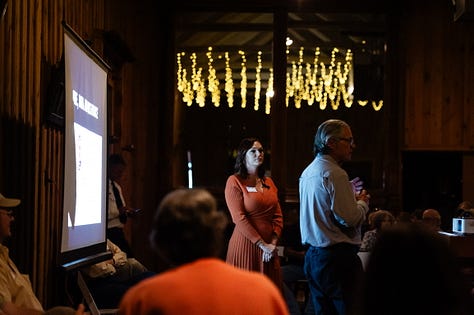Fire Forum Recap: Cloudcroft Residents Get Crash Course in Wildfire Preparedness
Five expert panelists address prevention, mitigation, and insurance concerns. Here's a summary of what went down Wednesday evening.
Cloudcroft Reader hosted the Cloudcroft Fire Risk forum at the Lodge Pavilion on Wednesday night—and many village residents were relieved to know the emergency sirens sounding off were simply a test, part of Fire Chief Erich Wuersching’s presentation.

With more than 200 attendees, the rustic and lovely Lodge Pavilion venue served as both a cozy setting and a subtle reminder of the importance of fire mitigation and preparedness in our community.
The site of the original Lodge, built in 1899 across the intersection from the Pavilion, burned down in 1909, and the Lodge was later rebuilt in 1911, which is where we see it today.
Our expert panel included:
Caleb Finch, District Fire Management Officer for the Sacramento Ranger District and Deputy Incident Commander for a National Incident Management Team;
Abigail Plecki, Community Wildfire Defense Grant Coordinator for the New Mexico Forestry Department;
Mario Romero, Chief Executive Officer and General Manager for the Otero County Electric Cooperative;
Erich Wuersching, Volunteer Fire Chief and Emergency Manager for Cloudcroft, and;
Ashley Dalton, Insurance Agent for Ashley Dalton Insurance Agency and “Fire Safety Queen”
The Wildland Urban Interface Project
Caleb Finch, a former hotshot and current Fire Management Officer for the Sacramento Ranger District, spoke on the National Forest Service's efforts to mitigate fire in the area, including upcoming Wildland Urban Interface (WUI) projects.
Our takeaways:
The Sacramento Mountain Range is listed in the top 1% of “at-risk” firesheds—and Cloudcroft is a “community at risk.”
Between 2003 and 2010, prescribed (RX) burns, commercial and non-commercial thinning, and mastication projects were completed in the forest surrounding Cloudcroft. Several Geronimo Street attendants had questions about the “tinder-like” masticated wood in the National Forest behind their homes. Finch addressed the concern that these were high-risk fuels, saying that masticated wood would “reduce the intensity of a fire.”
The WUI Maintenance Project is set to maintain 2,956 acres, emphasizing Cloudcroft's South and Western boundaries. Necessary surveys for wildlife and botany have been completed, and heritage surveys will begin in the spring of 2025. Fuels reduction work is slated to begin late in the summer of 2025.
“Landscape projects,” including RX burns, thinning, and mastication, are ongoing for the 16 Springs and Jim Lewis areas and are slated for 2025 and beyond for Denny, Curtis, and the James Canyon WUI locations.
The National Fire Protection Association provides infographics for creating a defensible space around your home, available here.
Cloudcroft Reader recently interviewed Finch and his Fire Management Team. You can catch Part One here.









Hazardous Fuels on Non-Federal Lands Grants
Speaker Abigail Plecki informed the forum about several grants available through the State of New Mexico Energy, Minerals and Natural Resources Department (EMNRD).
Plecki shared her three “favorites, with the most funding”:
The Community Wildfire Defense Grant (CWDG) has $10 million in funding for fire mitigation activities from the 2020 Otero County Community Wildfire Protection Plan (CWPP). Interested non-profits, local governments, tribes, and state forestry agencies can contact Plecki at Abigail.Plecki@emnrd.nm.gov.
Hazardous Fuels Treatments on Non-Federal Lands (NFL) Grants allow $400,000 in funds for United States Forest Service-adjacent private and municipal lands. Local governments, political subdivisions of the state, and tribes can contact Capitan District staff.
$2 million in funds are available for “fire mitigation activities, project planning, and workforce development on public and private lands” through the Forest and Watershed Restoration Act (FAWRA) Grant. Interested parties can inquire with Mitch Harper at Mitchell.harper@emnrd.nm.gov or Trystan Harpold at Trystan.Harpold@emnrd.nm.gov.
A Challenge to Co-Op Members: Aid in Fire Prevention
Otero County Electric Cooperative (OCEC) CEO and Manager Mario Romero addressed the stakeholders and co-op members about the importance of the Co-Op’s vegetation management efforts, appealing to members to “please aid our efforts rather than be a hindrance.”
OCEC currently serves 21,677 meters across 2,824 miles of line in Otero, Lincoln, Chaves, and Socorro counties. OCEC Linemen repaired burned structures and restored power in the Alto area after the Ruidoso area fires.
Romero’s presentation addressed the following:
Utility Right-of-way and easements allow OCEC vegetation management to remove trees that endanger power lines and pose a fire risk during red-flag days and other high-risk fire conditions.
OCEC “is not considering” implementing Public Safety Power Shutoffs. PNM, New Mexico’s largest electricity provider, recently announced plans for widespread power shut-offs to mitigate fire risk. Romero cites OCEC’s smaller employee base and vast coverage territory as unsuitable for planned shutoffs due to the extended time members would go without power while crews inspect “every mile of the line before restoring power.”
Romero spoke of the shared motivation between OCEC and its members to mitigate fire risk to avoid liability and future litigation if a fire starts. During the Q&A following his presentation, Phyllis Turner asked if burying the powerlines would reduce the fire risk.
OCEC Board of Trustees member Marty Mills addressed the query, stating that “yes,” buried lines reduce risk—at unrealistic costs. A recent buried line project was cited at nearly $1 million per mile of line.
Have a local business that cares about the health of Cloudcroft?
Learn about sponsorship opportunities for your business in support of the Reader. Contact us for more information at sponsor@cloudcroftreader.com
Cloudcroft Reader is proud to be sponsored in part by businesses like High Altitude, Cloudcroft’s favorite outdoors outfitter located on Burro Avenue.
Show and Yell: Cloudcroft’s Emergency Alert Systems Go
Chief Erich Wuersching’s presentation surprised the forum (and the Village) when his department demonstrated the village sirens. All citizens in the area should have received a Wireless Emergency Alert (WEA) through their phones, notifying them of the test.
(Note: If you did not receive a WEA informing you of the sirens test, you can change the settings in your phone. Visit here for more info.)
Wuersching focused on the Village’s planning and prevention efforts, citing treatments in 2014 and 2019 and $300,000 in NFL funding available in the fall of 2024.
The Cloudcroft VFD partners with the FireWise program for individuals and communities and currently has an Insurance Services Office (ISO) rating of 3. This makes Cloudcroft the highest-ranked, fully volunteer municipal fire department in the state.
The Village has a “new to us” ladder engine, and a new structural/wildland fire engine is “due to arrive later this fall.”
Wuersching provided the available avenues for emergency alert notification:
Reverse 9-1-1 and Otero Alerts (Genasys)
Audible Sirens: and we now know they work.
FM Radio: Tune into Rock 97.9 for emergency alerts.
Social Media: Alerts should be announced on the VFD and Village Facebook pages and the Watch Duty app.
Cloudcroft is in the final stages of getting a new app that will alert villagers to Firewise meetings, CPR classes, water outages, neighborhood watch info, and more.
After the Moser Fire, Cloudcroft Reader published the Village of Cloudcroft Emergency Preparedness Plan, which you can access here.








Firsthand and a Wealth of Experience: The Fire Safety Queen
Ashley Dalton is no stranger to the effects of fire—she lost her Ruidoso-based office through severe flash-flooding damage that swept through the burn scars caused by this summer’s South Fork Fire.
Dalton shared that after the McBride and other area fires, she was curious about how ISO ratings were given. She said she was “motivated by the data,” so she partnered with other members of the fire forum panel and “did the research.”
Throughout learning about fire risk and climate mapping, Dalton has made fire insurance coverage her passion and has become the self-proclaimed Fire Safety Queen.
Here’s a recap:
Verisk and CoreLogic produce data and wildfire maps that insurance companies use. They determine risk based on the “quality of your local fire department, including staffing levels, training, and (your) proximity to the firehouse.” They also use data on “water supply, including the prevalence of fire hydrants and how much water is available to put out fires, [and the] quality of the area’s emergency communications system (911). An extra 5.5% (of data) can come from community outreach, including fire prevention and safety courses.”
Catastrophe Model summaries use historical data to realistically simulate potential value loss. They include “weather, fuels, and ignition data.”
Dalton ran a “Wildfire Risk Rater,” which showed Cloudcroft at “Severe Risk” for all 1,045 homes on the map.
Dalton says it’s hard to get homeowner’s insurance in fire-prone areas “because Record-breaking wildfires in recent years have inspired homeowners' insurance companies to reconsider the risks of insuring homes in fire-prone areas. Many traditional carriers refuse to insure properties in these areas, and others have stopped renewing policies. Insurers don’t want the liability, and dry seasons are getting longer while wet seasons are getting shorter. The Institute of Insurance Information notes that wildfires accounted for $18 billion in insured losses in 2018, compared to $15 billion the previous year.”
Homes are considered insurability based on construction type, roof type, renovations, condition, and size. Mitigation actions include keeping vegetation “at least five feet away from structures " and focusing on FireWise neighborhoods.
Cloudcroft’s Hazard Risk was listed as very high, with over 100% of communities in the U.S. and our neighboring community of High Rolls. La Luz was listed at 80%, Tularosa at 79%, and Alamogordo at 66%.
According to Dalton, insurance companies move, tighten underwriting, change policies, cut advertising, and reduce commissions and employees when they lose money in at-risk territories.
Dalton advocated for education, reporting positive changes promptly, creating defensible space, and partnership as the path forward.
Throughout the evening, it was apparent that all the expert panel members were passionate about educating and empowering our mountain community on fire risk and prevention. After all, the Sacramento Mountains are their home, too.
We thank our generous sponsors for the Cloudcroft Fire Risk Forum: The Lodge at Cloudcroft, the Otero County Electric Cooperative, Inc., Crystal Tompkins Photography, and Drew Gaines, our videographer.
We look forward to publishing our documentary of this educational and informative community event soon.








The reporting no one else does.
Become a Cloudcroft Star. Show us you like what we are doing. Your pledge of support helps us keep the Cloudcroft community informed on issues and people that matter.
Special thanks to our Cloudcroft Stars who have made pledges:
Linda Hamilton, Suzannah Cox, Laryssa Alvarez, Gina Sweeney, Lynn Owen, Diane Thomas, Brian Risinger, Craig Turner, Carl Wyatt, Betty Sheker, Carie Mckinney, Dana Dunlap, Rebecca Barrows, Judith Langlois, Jim & Francis Curtis, Cheri Hass, Kurt Kochendarfer, Stan and Ginger, Alexandra Carilli, Greg Switzer, J & S Blanchett, Jan Graffunder, Barbara Hoskins, Martha & Larry Dahl, Linda Meyer, Tom McLaughlin, Jessie Willett, Heidi Gibbons, Karen Highfill, Herman Graffunder, Michael Johnson, Anonymous, Cloudcroft Chamber of Commerce, Earle & Dixie Neill, Tracy Lockhart, Bill Sandusky, Sandra Barr, Pat Ray, Robert Mace, Mary Bott, Barbara Scheuter, Cynthia Buttram, Andra Sanders, Tod Taylor, Donna G Casey, Kathy Lee Alvoid, Valerie Stagaman, Nancy Penner, Gerardo Acuna, Marietta Crane, Rodney Slaton, Randy Melton Electric, Amy Coor, Michael London, Nikki Castle, Joan Nussbaum, Rachel Truex, Cheryl Puterbaugh, Mark Ferring, Lisa & Greg Spier, Kay Magill, Anne Spier, Mark Tatum, Jonathan Coker, Stephanie Collins, Carl Milburn, Judy Gordinier, Glenn Edwards, Anonymous, John Sarrels, Kenna Darling.
Cloudcroft Reader is proud to be sponsored in part by businesses like:
Cloudcroft Therapeutic Massage | Providing pain relief and injury recovery since 2003 | Reach them at 575-415-4756




